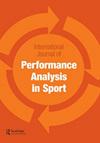Movement analysis of match play in U16-U21 youth Hungarian soccer players - the influence of age, position, and contextual variables
IF 1.6
4区 教育学
Q1 Health Professions
International Journal of Performance Analysis in Sport
Pub Date : 2023-05-04
DOI:10.1080/24748668.2023.2219490
引用次数: 0
Abstract
ABSTRACT The purpose of this study was to demonstrate the locomotor match-performance of youth Hungarian football players according to age groups, playing positions and effects of contextual match factors. The sample consisted of 574 individuals in four youth age groups (U16, U17, U19, U21) in four playing positions: central defenders (n = 139), fullbacks (n = 148), central midfielders (n = 185), and forwards (n = 102). Tactically, all teams used a 4-4-2 diamond formation. Data was collected from 114 matches from elite Hungarian football academy matches during the 2018–2019 season, using a GPS technology (10 Hz). The main results were: (a) U16, U19, U21 age groups matches played against strong opponents presented greater values (but not significantly) of high-intensity running distances compared to matches against weak opponents; (b) U21 players covered greater high-intensity running distances when winning than drawing the matches; (c) the U16, U19, U21 age groups performed better (but not significantly) at home than away in terms of high-intensity running. The forwards (735 ± 176 m) and fullbacks (654 ± 185 m) performed best in total high-intensity running (>19.8 km/h). With regard to maximum speed, forwards reached significantly higher results (30.44 ± 1.64 km/h) than players in other positions. Since international football players demonstrate better measures in high-intensity running and sprinting than Hungarian players.匈牙利U16-U21青年足球运动员比赛动作分析——年龄、位置和语境变量的影响
摘要:本研究旨在探讨匈牙利青少年足球运动员在不同年龄段、不同位置的运动比赛表现,以及相关比赛因素的影响。样本由四个青年年龄组(U16, U17, U19, U21)的574人组成,他们在四个位置上:中卫(n = 139),边后卫(n = 148),中场(n = 185)和前锋(n = 102)。从战术上讲,所有球队都采用了4-4-2菱形阵型。使用GPS技术(10 Hz)收集了2018-2019赛季匈牙利精英足球学院比赛的114场比赛的数据。主要结果为:(a) U16、U19、U21年龄组与强对手比赛的高强度跑动距离值高于弱对手比赛的高强度跑动距离值(但不显著);(b) U21球员在获胜时的高强度跑动距离大于平局;(c) U16、U19、U21年龄组在高强度跑动方面的主场表现优于客场(但不显著)。前锋(735±176 m)和边后卫(654±185 m)在总高强度跑动(>19.8 km/h)中表现最好。在最大速度方面,前锋的成绩(30.44±1.64 km/h)明显高于其他位置的球员。因为国际足球运动员在高强度的跑步和冲刺方面比匈牙利球员表现得更好。
本文章由计算机程序翻译,如有差异,请以英文原文为准。
求助全文
约1分钟内获得全文
求助全文
来源期刊

International Journal of Performance Analysis in Sport
SPORT SCIENCES-
CiteScore
4.70
自引率
4.80%
发文量
38
审稿时长
>12 weeks
期刊介绍:
The International Journal of Performance Analysis in Sport aims to present current original research into sports performance. In so doing, the journal contributes to our general knowledge of sports performance making findings available to a wide audience of academics and practitioners.
 求助内容:
求助内容: 应助结果提醒方式:
应助结果提醒方式:


